Basic garments are the same for men and women, differing only in the length. They consist of a camisa, bragas (men) , saya (Castille) or gonela (Aragon), pellote, piel/almejía/almexia/aljuba, garnacha, and various forms of mantles.
Known as chemise in other parts of Europe, the is the fine layer of fabric next to the skin. While other countries preferred a yellow-ish or gray-ish color, numerous literary works allude to the brilliant white of the camisa. The camisa comes in two basic forms, both with long sleeves: the loose shift, and one that is tightened with cords at either the back or the sides. In addition, one version of the man's fitted camisa also fastens between the legs. A new innovation in the 13th century was the addition of gold, silver, and colored silk embroidery, termed the camisa magomada. There are some indications of lacing at the wrists.
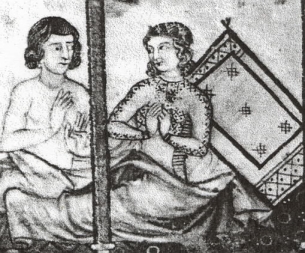
Above: Pillow of San Fernando. Real Chapel, Madrid
Left: From Cantiga 312 Center: Right: From Cantiga 22
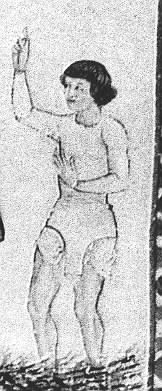
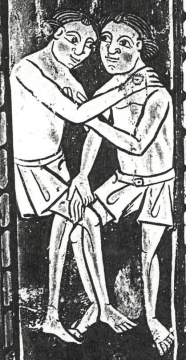
Left: From the Cathedral at Teruel
Right: Detail from Labors of the Months of May and June,
ceiling board from a house in calle de Lladó, Barcelona
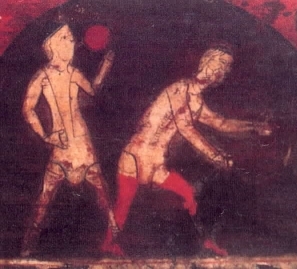
In previous centuries, bragas was the term applied to long or short breeches, but, in the 13th century, bragas were always quite short, and fastened with cords or leather strips. Hosen covered to mid thigh, and were fastened with cords, clasps, or garters. it is common for clergy and commoners to roll their hosen just below the knee. For more information about bragas (braies) see notes from Aenor d'Anjou.
The Saya
(Castille) or Gonela
(Aragon)
The saya is the gown worn directly over the camisa,
and comes in two basic versions, corresponding to the two versions of
the camisa. The most popular is the loose saya, which
could fasten at the neck with buttons. The closely-fitted saya
was tightened with lacing at either the back or the side (encordadas).
Usually the the lacings did not close the garment completely, but gaped
to show the camisa underneath. Both forms of the saya
could be sleeved (cozedizas) or sleeveless (ecotadas);
sleeves were cut separately, then joined to the body. The fit is very
smooth, lacking the "bunching" seen in clothes with a "T"
construction. Pendant sleeves could also be added to the shoulders, and
are often seen on minstrels and dancers. Neck and arm openings were often
emphasized with trim.
These terms supplant, for the most part, the older term brial; when used, brial now seems to indicate a garment exclusively worn by women- a rich garment with a train, fitted with laces, that is sometimes worn with a belt.
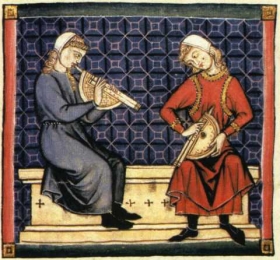
Left: From Cantiga 9
Right: Liber Feudorum Ceritaniae, folio 71: Betrothal of
the Count of Rousillon
with the daughter of the Viscount of Béziers, miniature. Archives
of the Crown of Aragon, Barcelona

According to Bernis and Menéndez-Pidal ( ) only young girls and courtesans appear in a single dress. Over the saya was worn the pellote, which was cut somewhat fuller, and could be trimmed with silver, buttons, crystals, and long cords. (Unfortunately, representations don't give us a lot of clue just how this was done!) The pellote assumed three basic forms. The first was loose, with sleeves shorter than the saya. A holdover from the garments of previous centuries, this style is always seen on the Virgin Mary, and in the garments of Moors and Jews. The second style is loose, but has no sleeves; visual sources indicate that women preferred this sleeveless style. The third style corresponds to the sideless surcoat seen in other parts of Europe, and is often worn over the saya encordada. An exaggeration of continental fashion, it is seen on queens, their retinue, concubines, and courtesans. Sometimes these were "fringed" at the bottom, as seen in the pellote of Enrique I annd below.
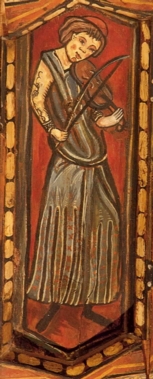


The piel, also formerly known as the pellizon, is generic term for an outer garment that gets its name from a lining of fur. Similar to Moorish garments, they often had rich embroideries on the sleeves. We know that these garments were prized; accounts tell how the Moors received in payment Pamplonan knives and aljubas, and aljubas was used as part of the ransom for the return of captives.
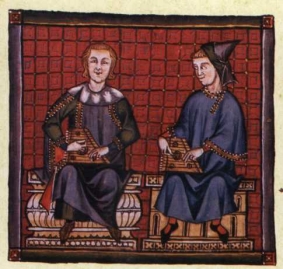
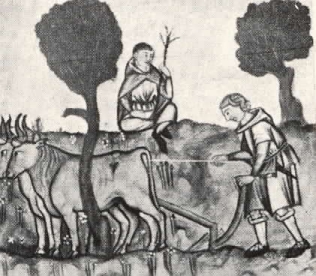
The rectangular mantle of previous centuries is now rarely seen. Instead, a variety of circular and semi-circular mantles appear. Some of the mantles fasten with cords, some without. The long-lived mantle with an opening on the left hand side survives, but it is often seen in this century with skin around the neck (almuza/muza), and that only on men. There are also examples of garments that correspond to the modern poncho--the balandra, which is essentially a tabard with a hood is seen only on rural workers, and the capa aguadera, which is a rectangular poncho with fur lining. Also used by women is the alquice, which seems to be a large, bordered, rectangular piece of fabric. The name probably comes from the name of the fine thin fabric, for we know that the 15th century Moorish quezote was an article made of fine linen cloth.
13th Century Headwear and Footwear
13th Century Accessories
13th Century Bibliography
13th Century Gallery of Images
Home

